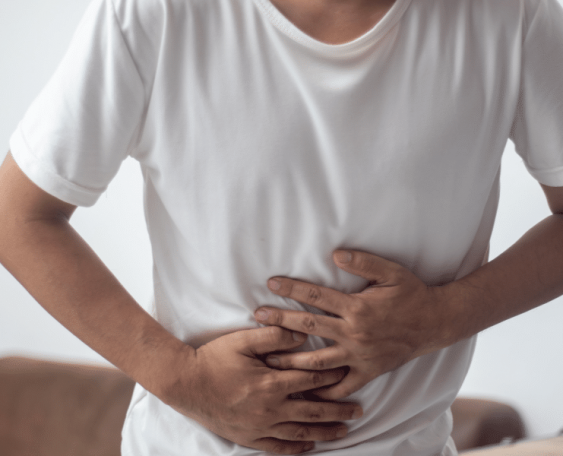KEY TAKEAWAYS
- Food poisoning symptoms appear quickly, often within 30 minutes to 6 hours after exposure, while stomach bug symptoms usually develop 12 hours to 10 days after contact with the pathogen.
- Food poisoning generally clears up faster, often within a few hours to several days, whereas stomach bugs typically last at least a day or two, with some cases extending over a week.
- Food poisoning affects approximately 48 million people annually, making it more common than stomach bugs, which impact about 19-21 million people each year.
What's the Difference Between Food Poisoning and a Stomach Bug?
Having food poisoning vs. a stomach bug is nauseatingly similar, but there are two notable distinctions:
- When you start feeling sick
- How long symptoms last
Food poisoning symptoms show up much sooner after exposure. Depending on the type of contaminant, you may start to feel sick as soon as 30 minutes after exposure. “Lag times” of around six hours are typical.
By contrast, you’re unlikely to see stomach bug symptoms sooner than 12 hours after coming into contact with the underlying pathogen. Depending on the bug, it might be up to 10 days before you feel sick.
Food poisoning symptoms also tend to clear the system faster. Some resolve in a few hours. Others last for several days. Most cases of the stomach bug last at least a day or two.
Some less common viruses can keep you ill for over a week. Doctors recommend seeking medical attention if your stomach bug case lasts more than 72 hours.
Importantly, food poisoning is more common than the stomach bug. Approximately 48 million people contract food poisoning annually, while only 19–21 million get a stomach virus.
Signs and Symptoms of Food Poisoning and Stomach Bug
No matter if it’s food poisoning or a stomach bug you will probably have at least some of the following symptoms:
- Nausea
- Vomiting
- Diarrhea
- Stomach pain or cramping
- Fever
These experiences are associated with both food poisoning and stomach bugs. To tell the difference, you’ll need to look at the more subtle symptoms accompanying each illness.
Some people with food poisoning also notice bloating, gas, headaches, fever, and sweating. A stomach bug is also more likely to cause stiff and aching joints. However, since not all patients experience these secondary symptoms, the best way to distinguish food poisoning vs. stomach bug is to look at how and when the symptoms start.
Food poisoning symptoms manifest suddenly and intensely. You can go from being healthy to feeling severely ill in moments. The stomach flu typically develops more gradually and may not be as severe.
Causes and Culprits
Food poisoning and stomach bugs occur when bacterial or viral pathogens enter the body. The type of pathogen underlying each is usually different, but there are exceptions.
Surface Contaminants
Viruses, parasites, and bacteria grow on food that sits out too long or that isn’t cooked properly. Different contaminants cause different types of food poisoning. Common causes of food poisoning include:
Cross-contamination is a common cause of food poisoning, particularly in kitchens that fail to implement proper cleaning protocols.
For example, suppose someone prepares a contaminated batch of hamburger meat on a cutting board. Another person picks up the cutting board and begins chopping carrots without washing the board first. The carrots will pick up the contaminating microorganism, potentially making someone sick.
Viral Infections
Stomach bugs occur due to viral infection. Highly contagious norovirus, rotavirus, adenovirus, and astrovirus are common causes.
Viral food poisoning may also be contagious. The most common example is norovirus, which can be contracted by eating contaminated food or touching surfaces with the virus.
Another example is hepatitis A, which most patients get from consuming contaminated food or beverages. It causes short-term liver damage and is highly contagious through close contact. Hepatitis A can spread before symptoms arise.
Recovery Tips for Food Poisoning and the Stomach Bug
Most people don’t need to solve the food poisoning vs. stomach bug riddle to make a full recovery. Resting and hydrating at home are typically enough for most mild to moderate cases.
Eating can feel challenging when you have an upset stomach, but supporting your body with safe and easily digestible food is essential. Try starting with a recovery diet made up of foods unlikely to upset your stomach, such as:
- Plain bread or toast
- Unflavored oatmeal
- White rice
- Applesauce
- Bananas
- Warm broth
- Clear liquids
Eat something daily and drink plenty of fluids to stay hydrated and prevent malnutrition. As you start to recover, you can begin adding other foods. Avoid dairy and anything high in sugar, fat, fiber, or additives until fully recovered. Consult a medical professional for recommendations if you cannot keep food down.
Prevention Techniques
Hygiene is essential to preventing food poisoning and stomach bugs. Wash your hands frequently, including before eating or preparing food and after using the bathroom, touching waste, or caring for an ill person.
Follow proper food safety procedures to avoid food poisoning. Refrigerate perishable foods and avoid allowing them to sit unrefrigerated for more than two hours. Set your refrigerator to 40 °F or below and your freezer to 0 °F or below.
Cook red meat, poultry, and seafood to the correct internal temperature. Keep a meat thermometer and temperature chart on hand to check temperatures before serving. If you can’t serve cooked food immediately, maintain it at 140 °F or higher until served.
When eating out, look for signs of professional food safety protocols. For example:
- Hot dishes should be hot, not lukewarm.
- Cold dishes should be served at refrigerator temperatures.
- Food preparation staff should wear gloves and use tongs to work with food.
- Food safety certificates should be on display.
- No staff should show signs of illness, such as coughing or sneezing.
You can also check a restaurant’s recent inspection score on your health department’s website. The FDA requires most food establishments to undergo an inspection every six months.
When Should You See a Doctor?
While most people recover from stomach bugs and food poisoning on their own, some patients become seriously ill. The Centers for Disease Control and Prevention recommends seeing a doctor if you experience any of the following symptoms:
- Bloody diarrhea
- Diarrhea with fever above 102 °F
- Diarrhea for over three days with no improvement
- Inability to keep liquids down
Dehydration is a serious concern with food poisoning and the stomach bug. Seek medical attention immediately if you experience extreme thirst, reduced urination, dark urine, light-headedness, extreme fatigue, or sunken eyes and cheeks.
Another common sign of dehydration is reduced skin elasticity. If you pinch the skin gently and release it, it should flatten back to its normal state. Skin that fails to “snap back” usually indicates dehydration.
How To Report Food Poisoning
Food poisoning doesn’t need to be something that “just happens.” Every food service institution is responsible for keeping consumers safe from preventable food-borne illnesses. Contact your local health department if you suspect you contracted food poisoning from a food service establishment. Authorities can keep more people from getting sick by tracking potential outbreaks.
Contact Keep Food Safe for Help Taking Legal Action
If you contracted a severe case of food poisoning due to someone else’s carelessness, Keep Food Safe is here to ensure you know your full legal rights and options. A food safety lawsuit can help you recover compensation for medical costs, missed wages, pain, suffering, and other damages. Contact us today to connect with an experienced food safety lawyer.





